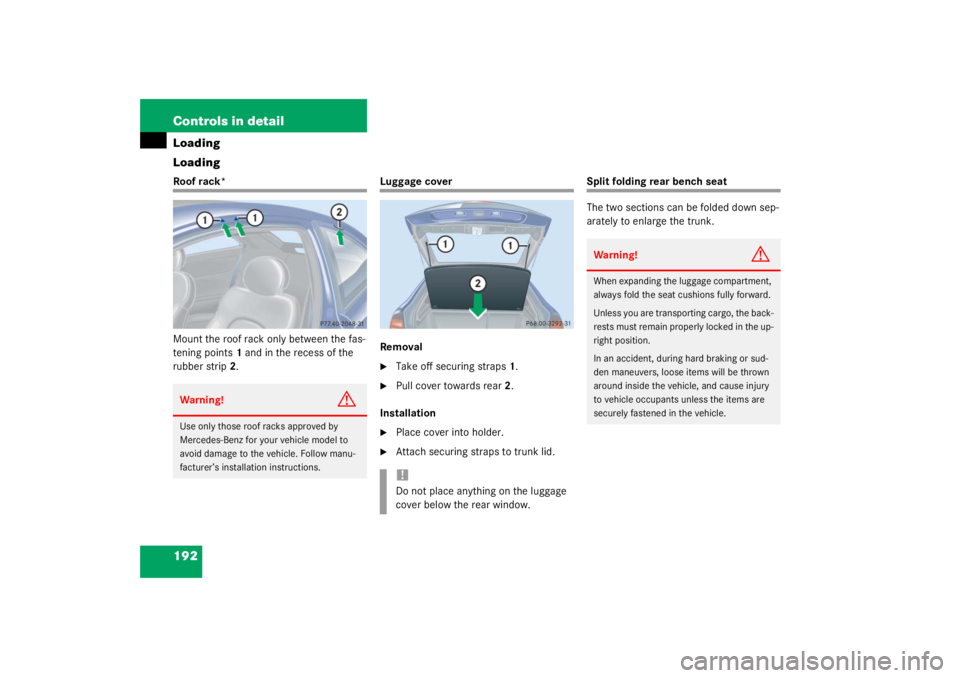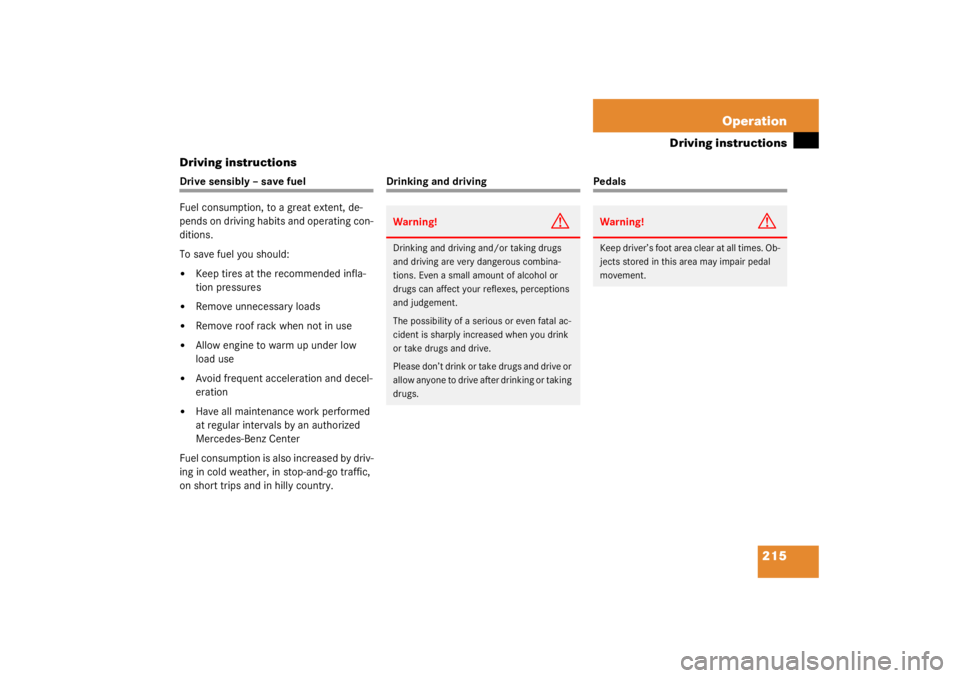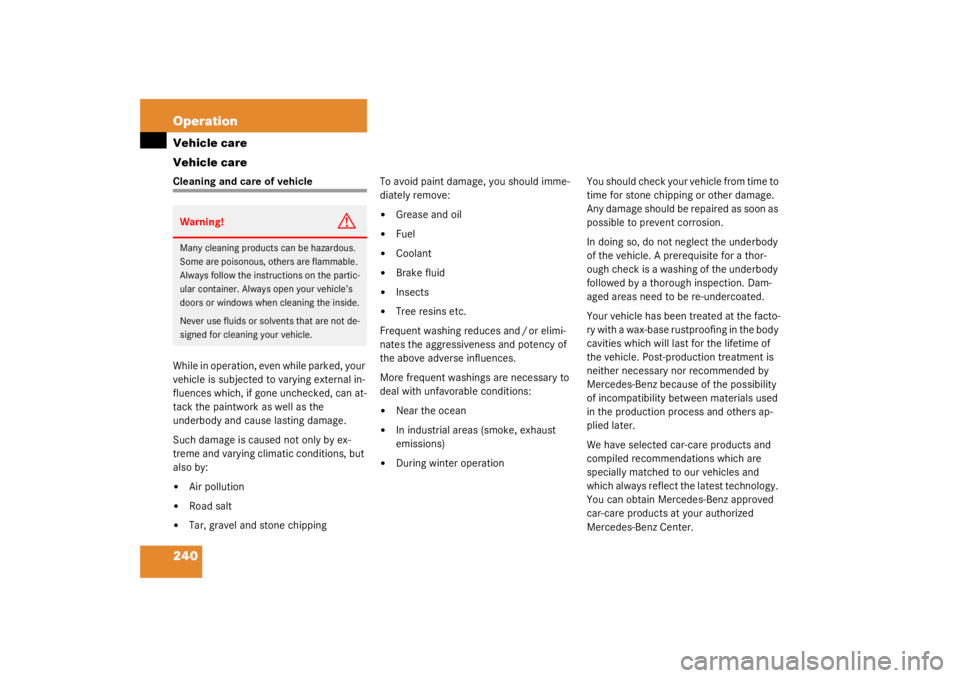Page 192 of 356

192 Controls in detailLoading
LoadingRoof rack*
Mount the roof rack only between the fas-
tening points1 and in the recess of the
rubber strip 2.
Luggage cover
Removal�
Take off securing straps 1.
�
Pull cover towards rear 2.
Installation
�
Place cover into holder.
�
Attach securing straps to trunk lid.
Split folding rear bench seat
The two sections can be folded down sep-
arately to enlarge the trunk.
Warning!
G
Use only those roof racks approved by
Mercedes-Benz for your vehicle model to
avoid damage to the vehicle. Follow manu-
facturer’s installation instructions.
!Do not place anything on the luggage
cover below the rear window.
Warning!
G
When expanding the luggage compartment,
always fold the seat cushions fully forward.
Unless you are transporting cargo, the back-
rests must remain properly locked in the up-
right position.
In an accident, during hard braking or sud-
den maneuvers, loose items will be thrown
around inside the vehicle, and cause injury
to vehicle occupants unless the items are
securely fastened in the vehicle.
Page 215 of 356

215
Operation
Driving instructions
Driving instructions
Drive sensibly – save fuel
Fuel consumption, to a great extent, de-
pends on driving habits and operating con-
ditions.
To save fuel you should:�
Keep tires at the recommended infla-
tion pressures
�
Remove unnecessary loads
�
Remove roof rack when not in use
�
Allow engine to warm up under low
load use
�
Avoid frequent acceleration and decel-
eration
�
Have all maintenance work performed
at regular intervals by an authorized
Mercedes-Benz Center
Fuel consumption is also increased by driv-
ing in cold weather, in stop-and-go traffic,
on short trips and in hilly country.
Drinking and driving
Pedals
Warning!
G
Drinking and driving and/or taking drugs
and driving are very dangerous combina-
tions. Even a small amount of alcohol or
drugs can affect your reflexes, perceptions
and judgement.
The possibility of a serious or even fatal ac-
cident is sharply increased when you drink
or take drugs and drive.
Please don’t drink or take drugs and drive or
allow anyone to drive after drinking or taking
drugs.
Warning!
G
Keep driver’s foot area clear at all times. Ob-
jects stored in this area may impair pedal
movement.
Page 240 of 356

240 OperationVehicle care
Vehicle careCleaning and care of vehicle
While in operation, even while parked, your
vehicle is subjected to varying external in-
fluences which, if gone unchecked, can at-
tack the paintwork as well as the
underbody and cause lasting damage.
Such damage is caused not only by ex-
treme and varying climatic conditions, but
also by:�
Air pollution
�
Road salt
�
Tar, gravel and stone chippingTo avoid paint damage, you should imme-
diately remove:
�
Grease and oil
�
Fuel
�
Coolant
�
Brake fluid
�
Insects
�
Tree resins etc.
Frequent washing reduces and / or elimi-
nates the aggressiveness and potency of
the above adverse influences.
More frequent washings are necessary to
deal with unfavorable conditions:
�
Near the ocean
�
In industrial areas (smoke, exhaust
emissions)
�
During winter operation You should check your vehicle from time to
time for stone chipping or other damage.
Any damage should be repaired as soon as
possible to prevent corrosion.
In doing so, do not
neglect the underbody
of the vehicle. A prerequisite for a thor-
ough check is a washing of the underbody
followed by a thorough inspection. Dam-
aged areas need to be re-undercoated.
Your vehicle has been treated at the facto-
ry with a wax-base rustproofing in the body
cavities which will last for the lifetime of
the vehicle. Post-production treatment is
neither necessary nor recommended by
Mercedes-Benz because of the possibility
of incompatibility between materials used
in the production process and others ap-
plied later.
We have selected car-care products and
compiled recommendations which are
specially matched to our vehicles and
which always reflect th e latest technology.
You can obtain Mercedes-Benz approved
car-care products at your authorized
Mercedes-Benz Center.
Warning!
G
Many cleaning products can be hazardous.
Some are poisonous, others are flammable.
Always follow the instructions on the partic-
ular container. Always open your vehicle’s
doors or windows when cleaning the inside.
Never use fluids or solvents that are not de-
signed for cleaning your vehicle.
Page 278 of 356
278 Practical hintsOpening/closing in an emergency
Opening/closing in an emergencyPanorama sliding/pop-up roof
The panorama sliding/pop-up roof drive is
located behind the lens of the interior over-
head light.
You can open or close the panorama slid-
ing/pop-up roof manually should an elec-
trical malfunction occur.�
Pry off lens1 using a screwdriver.
�
Slide both locking tabs 2 in direction of
arrow.
�
Lower rear of cover and remove.
�
Remove cover.
�
Obtain crank 3.
�
Insert crank 3 through left hand side
motor hole 4.
�
Turn crank 3 clockwise to:�
slide roof closed
�
raise roof at the rear
�
Turn crank 3 counterclockwise to:�
slide roof open
�
lower roof at the rear
The panorama sliding/pop-up roof must be
resynchronized after being operated man-
ually.
iDo not disconnect electrical connec-
tors.
Page 279 of 356
279
Practical hints
Opening/closing in an emergency
Synchronizing the panorama slid-
ing/pop-up roof�
Switch on the ignition.
�
Move the switch in the “close” direc-
tion and wait until the sunshades are
fully closed.
Hold the switch for approximately one
second.
�
Move the switch in the “open” direction
and wait until the sunshades are fully
opened.
Hold the switch for approximately one
second.
�
Move the switch in the “open” direction
and wait until the panorama slid-
ing/pop-up roof is approximately 4 in
(10cm) opened.
Hold the switch for approximately one
second.
�
Move the switch in the “close” direc-
tion and wait until the panorama slid-
ing/pop-up roof is fully closed.
Hold the switch for approximately one
second.
The panorama sliding/pop-up roof is syn-
chronized when the panorama slid-
ing/pop-up roof opens automatically.
Page 294 of 356

294 Practical hintsBattery
BatteryThe battery is located in the engine com-
partment on the right hand side.
Removal of filter box:�
Release the three clamps1.
�
Remove filter box.
Installation of filter box:
�
Insert filter box properly.
�
Secure it with the three clamps 1.
Warning!
G
Failure to follow these instructions can re-
sult in severe injury or death.
Never lean over batteries while connecting,
you might get injured.
Battery fluid contains sulfuric acid. Do not
allow this fluid to come in contact with eyes,
skin or clothing. In case it does, immediately
flush affected area with water and seek
medical help if necessary.
A battery will also produce hydrogen gas,
which is flammable and explosive. Keep
flames or sparks away from battery, avoid
improper connection of jumper cables,
smoking etc.
!Never loosen or detach battery termi-
nal clamps while the engine is running
or the key is in the starter switch. Oth-
erwise the alternator and other elec-
tronic components could be severely
damaged.
Have the battery checked regularly by
an authorized Mercedes-Benz Center.
Refer to Service Booklet for mainte-
nance intervals or contact your autho-
rized Mercedes-Benz Center for further
information.Warning!
G
Do not place metal objects on the battery as
this could result in a short circuit.
Use leak-proof battery only to avoid the risk
of acid burns in the event of an accident.
Page 296 of 356
296 Practical hintsBattery
Batteries contain materials that can harm
the environment if disposed of improperly.
Large 12-volt storage batteries contain
lead. Recycling of batteries is the preferred
method of disposal. Many states require
sellers of batteries to accept old batteries
for recycling.
iThe following procedures must be car-
ried out following any interruption of
battery power (e.g. due to reconnec-
tion):�
Set the clock (
�page 116) (vehi-
cles with COMAND*: see COMAND
operator’s manual).
�
Resynchronize the ESP
(�page 260).
�
Resynchronize side windows
(�page 184).
�
Resynchronize panorama slid-
ing/pop-up roof (
�page 188).
Page 316 of 356
316 Technical dataWeights
WeightsRoof load max.
220 lb (100 kg)
Trunk load max.
220 lb (100 kg)